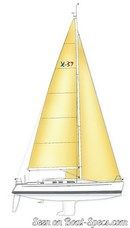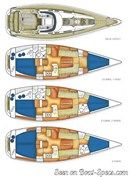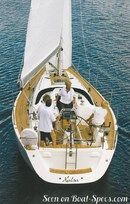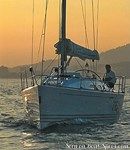X-37 Sport
Sailboat specifications
The X-37 is a 37’2” (11.35m) cruiser-racer sailboat designed by Niels Jeppesen (Denmark). She was built between 2004 and 2010 by X-Yachts (Denmark) with 148 hulls completed. The Sport version offers a deeper L-shaped keel bringing extra performance especially upwind.
The X-37 is as well listed, on Boat-Specs.com, in Standard and Shoal draft version (see all the versions compared).
The X-37 is as well listed, on Boat-Specs.com, in Standard and Shoal draft version (see all the versions compared).
X-37's main features
- Model
- X-37
- Version
- Sport
- Hull type
- Monohull
- Category
- Cruiser-racer sailboat
- Sailboat builder
- Sailboat designer
- Country
- Denmark
- Construction
- GRP (glass reinforced polyester):
Sandwich fiberglass polyester - Number of hulls built
- 148
- First built hull
- 2004
- Last built hull
- 2010
- Appendages
- Keel : L-shaped keel (with bulb)
- Helm
- Single helm wheel
- Rudder
- Single spade rudder
- Unsinkable
- No
- Trailerable
- No
- EC design categoryiThe CE design category indicates the ability to cope with certain weather conditions (the sailboat is designed for these conditions)
A: Wind < force 9, Waves < 10m
B: Wind < force 8, Waves < 8m
C: Wind < force 6, Waves < 4m
D: Wind < force 4, Waves < 0,5m - A
- Standard public price ex. VAT (indicative only)
- N/A €
X-37's main dimensions
- Hull length
- 37’ 2”11.35 m
- Waterline length
- 32’ 1”9.79 m
- Beam (width)
- 11’ 5”3.48 m
- Draft
- 7’ 6”2.3 m
- Mast height from DWL
- 60’ 5”18.4 m
- Light displacement (MLC)
- 14110 lb6400 kg
- Ballast weight
- 5986 lb2715 kg
- French customs tonnage
- 12.99 Tx
X-37's rig and sails
- Upwind sail area
- 932 ft²86.6 m²
- Downwind sail area
- 1620 ft²150.5 m²
- Mainsail area
- 470 ft²43.7 m²
- Genoa area
- 462 ft²42.9 m²
- Solent area
- 369 ft²34.3 m²
- Jib area
- 293 ft²27.2 m²
- Symmetric spinnaker area
- 1150 ft²106.8 m²
- Rigging type
- Sloop Marconi 9/10
- Mast configuration
- Keel stepped mast
- Rotating spars
- No
- Number of levels of spreaders
- 2
- Spreaders angle
- Swept-back
- Spars construction
- Aluminum spars
X-37's performances
- Upwind sail area to displacementiThe ratio sail area to displacement is obtained by dividing the sail area by the boat's displaced volume to the power two-thirds.
The ratio sail area to displacement can be used to compare the relative sail plan of different sailboats no matter what their size.
Upwind: under 18 the ratio indicates a cruise oriented sailboat with limited performances especially in light wind, while over 25 it indicates a fast sailboat. - 270 ft²/T25.12 m²/T
- Downwind sail area to displacementiThe ratio sail area to displacement is obtained by dividing the sail area by the boat's displaced volume to the power two-thirds.
The ratio sail area to displacement can be used to compare the relative sail plan of different sailboats no matter what their size. - 470 ft²/T43.66 m²/T
- Displacement-length ratio (DLR)iThe Displacement Length Ratio (DLR) is a figure that points out the boat's weight compared to its waterline length. The DLR is obtained by dividing the boat's displacement in tons by the cube of one one-hundredth of the waterline length (in feet).
The DLR can be used to compare the relative mass of different sailboats no matter what their length:
a DLR less than 180 is indicative of a really light sailboat (race boat made for planning), while a DLR greater than 300 is indicative of a heavy cruising sailboat. - 193
- Ballast ratioiThe Ballast ratio is an indicator of stability; it is obtained by dividing the boat's displacement by the mass of the ballast. Since the stability depends also of the hull shapes and the position of the center of gravity, only the boats with similar ballast arrangements and hull shapes should be compared.
The higher the ballast ratio is, the greater is the stability. - 42 %
- Critical hull speediAs a ship moves in the water, it creates standing waves that oppose its movement. This effect increases dramatically the resistance when the boat reaches a speed-length ratio (speed-length ratio is the ratio between the speed in knots and the square root of the waterline length in feet) of about 1.2 (corresponding to a Froude Number of 0.35) . This very sharp rise in resistance, between speed-length ratio of 1.2 to 1.5, is insurmountable for heavy sailboats and so becomes an apparent barrier. This leads to the concept of "hull speed".
The hull speed is obtained by multiplying the square root of the waterline length (in feet) by 1.34. - 7.59 knots
X-37's auxiliary engine
- Engine(s)
- 1 inboard engine
- Engine(s) power
- 29 HP
- Fuel type
- Diesel
X-37's accommodations and layout
- Cockpit
- Closed aft cockpit
- Cabin(s) (min./max.)
- 2 / 3
- Berth(s) (min./max.)
- 4 / 8
- Head(s) (min./max.)
- 1 / 2
- Maximum headroom
- 6’ 1”1.87 m









X-Yachts X-37 interior and accommodations - - 8/9
Picture extracted from the commercial documentation © X-Yachts
Picture extracted from the commercial documentation © X-Yachts


X-Yachts X-37 interior and accommodations - - 9/9
Picture extracted from the commercial documentation © X-Yachts
Picture extracted from the commercial documentation © X-Yachts
Similar sailboats that may interest you:
Sailboats
First built hull
Hull length
1989
41’12.5 m
1992
37’ 5”11.4 m
2003
42’ 5”12.93 m
1987
36’ 4”11.05 m
1998
42’ 7”12.98 m
2017
40’12.2 m
2014
37’11.28 m
1994
33’10.06 m
1997
39’ 1”11.92 m
1998
35’ 2”10.73 m
2001
35’ 4”10.75 m
2006
37’11.29 m
2004
37’ 2”11.35 m
2011
37’ 8”11.5 m
2006
36’ 6”11.12 m